Missi Roti are savory and nutty flavored flatbreads made with a mix of whole wheat flour, gram flour and spices. Missi Roti is a North Indian specialty and is often made in various homes in the North Indian belt. I am sharing my family recipe that I have been making for many years now.
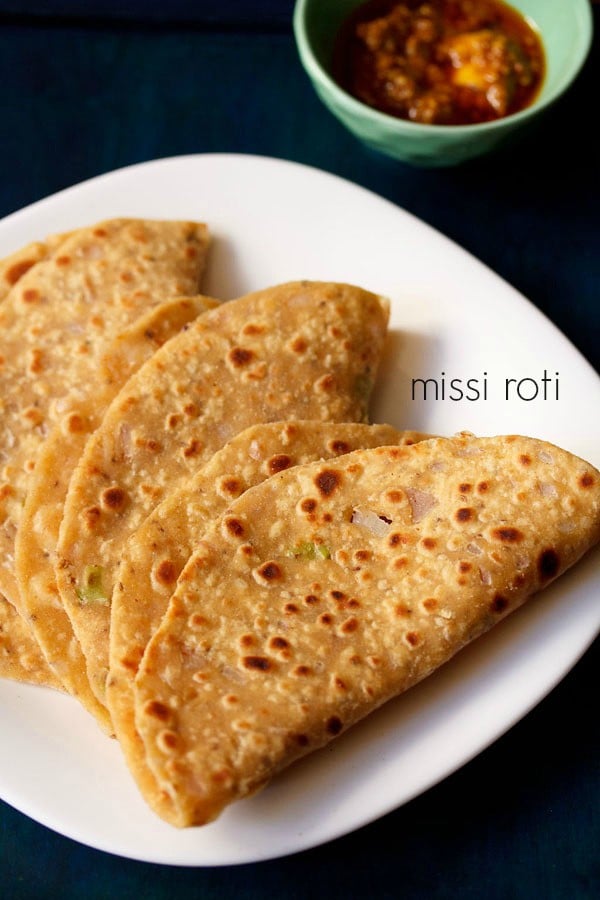
About Missi Roti Recipe
Missi Roti are simple, easy to prepare flatbreads made with a combination of whole wheat flour and gram flour. The flour mix is also flavored with carom seeds (ajwain), asafoetida, onions, green chillies and salt.
Adding a bit of oil and water in portions, a smooth and soft dough is made; which is later rolled into flatbreads. These rolled flatbreads are roasted on a flat skillet (griddle) or tawa with oil or ghee.
Missi Roti is also known as Besan Roti as besan a.k.a gram flour is one of the key ingredients. Gram flour imparts a nice nutty flavor to the roti. It also helps in making the roti slightly crispy.
There are some variations of this recipe. Some people also make it into layered crispy and flaky missi roti.
But we make it into a simple round roti and not the layered version. However if you want to make a crispy layered version then you can check this Paratha Recipe or Lachha Paratha for reference.
We always add onions to the dough. With onions, the roti tastes good. If you do not want to add onions, then you can add fenugreek leaves, spinach or grated veggies like carrots or beetroot.
The addition of veggies will make these rotis more healthy and a good way to include the veggies in the diet of kids who don’t like them.
To makes these besan ki roti, the proportion of whole wheat flour to besan added varies from family to family. We always use a 2:1 proportion of both whole wheat flour and gram flour respectively.
Missi roti can be served with a dal, aloo sabzi, matar sabzi or even a mango pickle or curd or butter.
I usually make them for breakfast and serve with mango pickle or lemon pickle. These rotis have to be served hot as on cooling they become slightly dense.
Some people confuse missi roti with Thepla. Even though the dough preparation looks similar but both these dishes are different.
Curd is always added to the thepla dough which gives it a slightly tangy taste. But curd is not added to the missi roti dough.
How to make Missi Roti
Make Dough
1. Take 2 cups whole wheat flour (240 grams), 1 cup besan/gram flour (100 grams), 1 teaspoon carom seeds (ajwain), a pinch of asafoetida (hing) and 1 teaspoon salt in a mixing bowl or a pan.
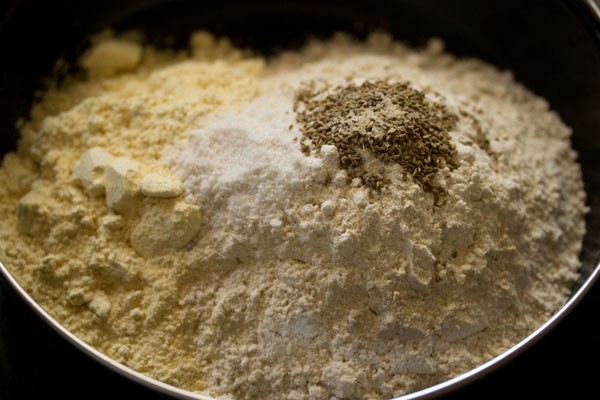
2. Add ⅓ cup finely chopped onions, 1 to 2 green chilies (1 teaspoon finely chopped) and 3 teaspoons oil. If the onions and green chillies are not finely chopped then they can come out while rolling the paratha.
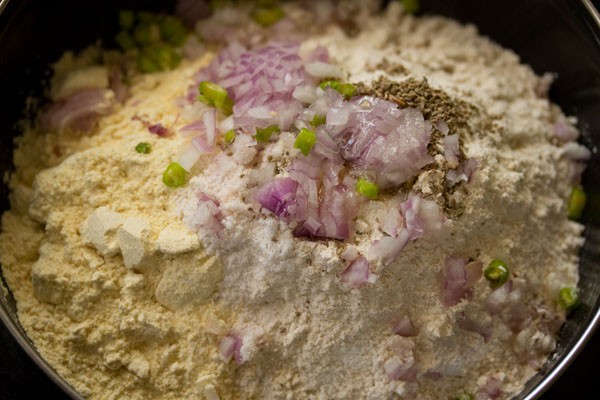
3. Mix very well with a spoon.
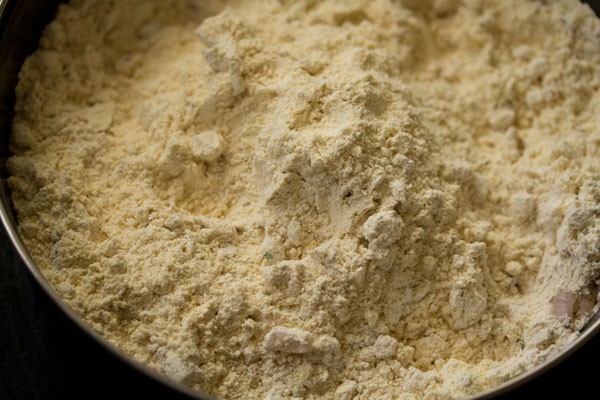
4. Then add ½ cup water.
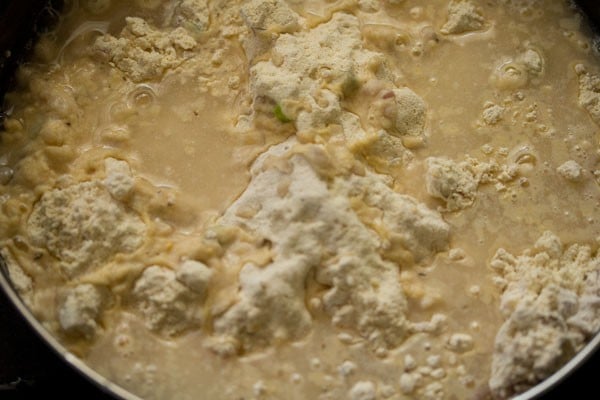
5. Begin to mix and knead the dough.
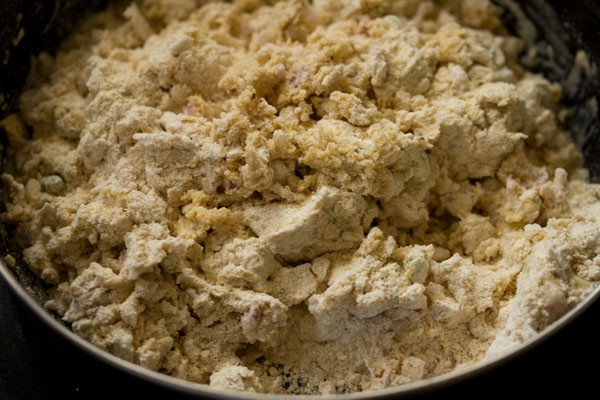
6. Add more water as required and knead to a smooth soft dough. Overall I added ¾ cup water.
The amount of water required depends on the quality of both the flours. So you can add ⅔ to ¾ cup water or more if required.
If dough becomes sticky, then add some more wheat flour. If the dough looks dry, then add a bit of water and knead again.

7. Allow the dough to rest for 10 minutes and then make medium-sized balls from the dough.
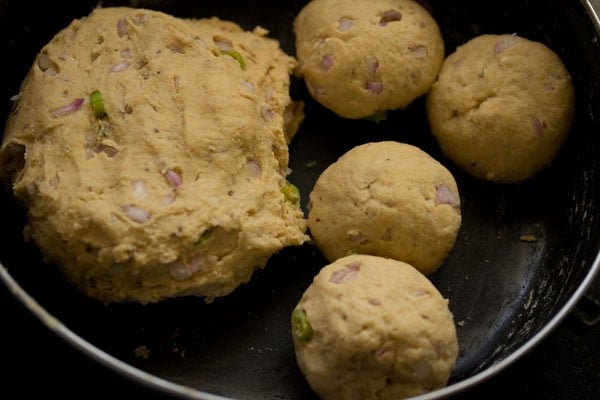
Make Missi Roti
8. Take the dough ball on the rolling board. Dust some whole wheat flour on both sides of the ball.

9. Roll to a circle of about 5 to 6 inches. Sprinkle some more flour if required while rolling. Roll to medium to medium-thick roti.
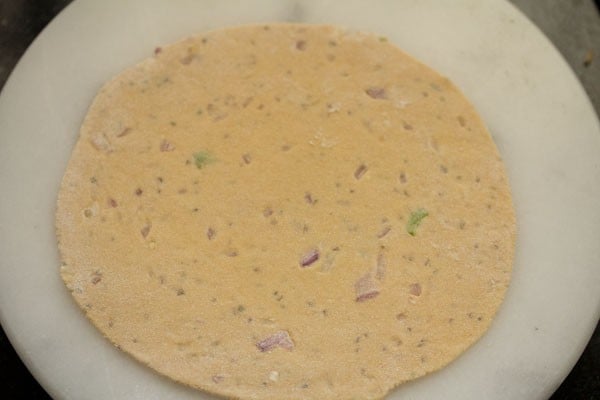
10. Place the roti on a hot tawa or skillet. The tawa should be hot and not at a low temperature.
Also keep the heat to medium-high to high. Do not keep the heat to a low.

11. When the bottom of the roti is partially cooked, flip the roti using a spatula or tongs.
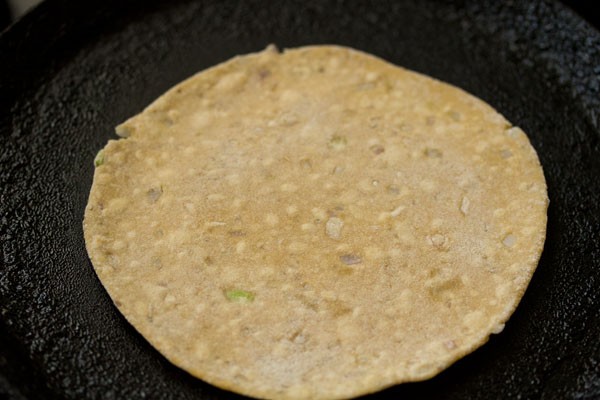
12. Spread ½ to 1 teaspoon of oil on the partly cooked part. We always use oil while roasting missi roti. But you can use ghee also.
The amount of oil to be applied depends upon your preference.

13. When the second side is cooked and brown spots can be seen, then flip again. Spread some ½ to 1 teaspoon oil on this side too.

14. Flip again.

15. Press the edges with a spatula so that the sides are also cooked well. Ensure that the roti edges are roasted properly as sometimes they can be undercooked.
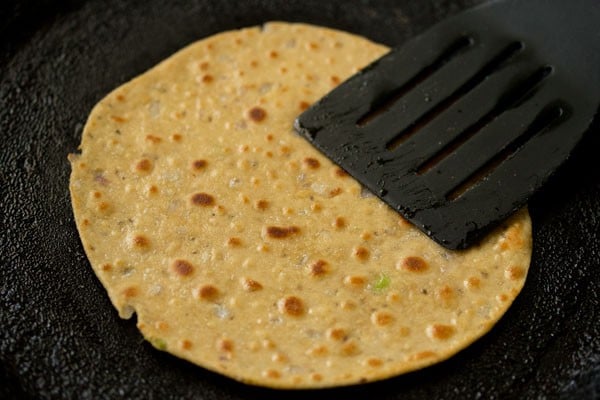
16. Flip once or twice more, so that the missi roti is evenly cooked and has some dark brown spots as seen in the below photo.
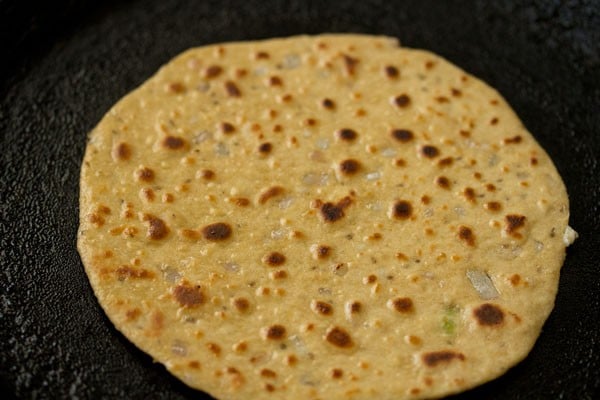
17. Serve the missi roti immediately or place them in a roti basket or a casserole and serve warm. Make them this way and stack them up in a roti basket or casserole.
While roasting the second roti on tawa, make sure that the tawa does not have any burnt or browned wheat particles. If any then clean the tawa with a kitchen paper towel.
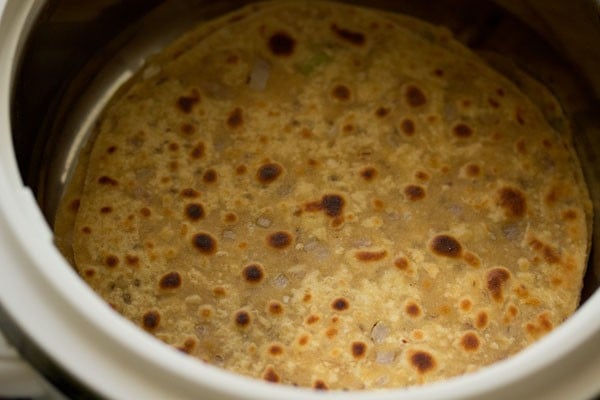
18. Serve missi roti hot or warm with any vegetable dish, dal or with a pickle or curd or butter.
It tastes so good that you can just have it plain also without any accompaniment. For best taste have them hot or warm.
Sometimes we have them as an evening snack with a cup of hot tea.
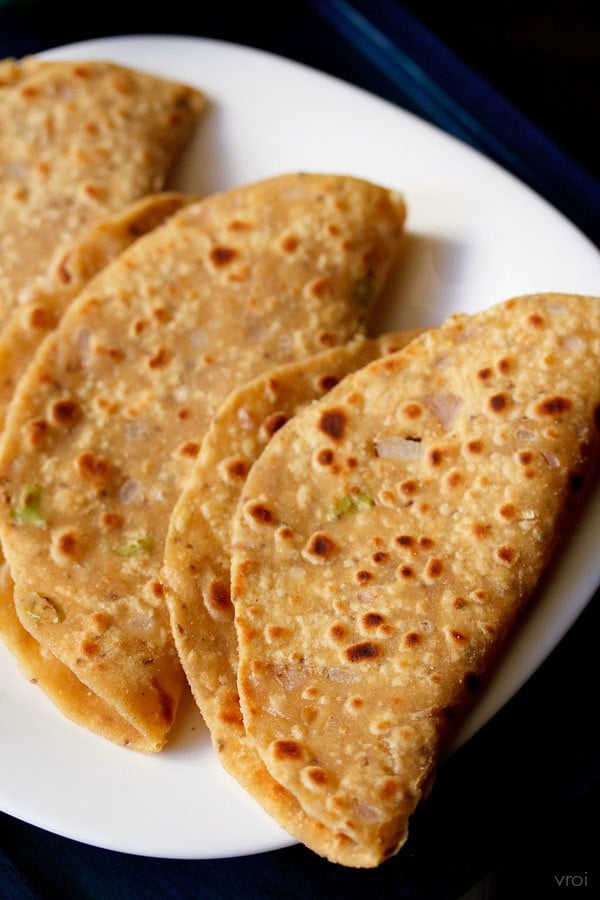
More tasty roti varieties
- Jowar roti – Healthy Sorghum Flour Gluten-Free flatbread.
- Bajra roti – Warming Millet Flour Gluten Free flatbread.
- Ragi roti – Calcium Rich Finger millet flour flatbread.
- Rumali roti – Thin soft flatbreads made mainly with whole wheat flour and all-purpose flour.
- Akki roti – Flatbreads made with rice flour and mix veggies.
Please be sure to rate the recipe in the recipe card or leave a comment below if you have made it. For more vegetarian inspirations, Sign Up for my emails or follow me on Instagram, Youtube, Facebook, Pinterest or Twitter.

Missi Roti Recipe (Gram Flour Flatbread)
Ingredients
- 2 cups (240 grams) whole wheat flour
- 1 cup (100 grams) besan (gram flour or chickpea flour)
- 1 teaspoon ajwain (carom seeds)
- 1 to 2 green chilies – finely chopped
- ⅓ cup (50 grams) grams onion – finely chopped
- 1 pinch asafoetida (hing)
- 1 teaspoon salt
- 3 teaspoon oil
- ⅔ to ¾ cup water or add as required
- oil as required while roasting roti
Instructions
Making dough
- Take the whole wheat flour, besan (gram flour) and ajwain (carom seeds) in a mixing bowl or a pan.
- Add finely chopped onion, chopped green chilies, a pinch of asafoetida (hing) and oil. Mix very well.
- Then add ½ cup water. Begin to mix and knead the dough.
- Add more water as required and knead to a smooth soft dough.
- I overall added ¾ cup water. The amount of water required depends on the quality of flour. So you can add ⅔ to ¾ cup water or more if required.
- Allow the dough to rest for 10 minutes and then make medium sized balls from the dough.
Rolling missi roti
- Take the dough ball on the rolling board.
- Dust some dry wheat flour on both sides of the ball.
- Roll to a circle of about 5 to 6 inches.
- Sprinkle some more flour if required while rolling. Roll to medium to medium thick roti.
Roasting missi roti
- Place the roti on a hot tawa or skillet. The tava should be hot and not at a low temperature.
- When the base is partially cooked, flip the roti.
- Spread some ghee or oil on the partly cooked part.
- When the second side is cooked and brown spots can be seen, then flip again. Spread some ghee or oil on this side too. Flip again.
- Press the edges with a spatula so that the sides are also cooked well.
- Flip once or twice more, so that the roti is evenly cooked. Also, do not cook too much as then the rotis will become dense.
- Serve the missi roti immediately or place them in a roti basket or a casserole and serve warm. Make rotis this way and stack them up in a roti basket or casserole.
- Serve them hot or warm with a sabzi, dal or with a pickle or yogurt or butter.
Notes
- For kids reduce green chilies or skip them.
- The recipe can be doubled or tripled.
- It can be packed for a tiffin box. However, it tastes best when served hot or warm.
- Remember to finely chop the onions and green chilies. Otherwise, the paratha will tear while rolling.
- You can use ghee instead of oil to roast the paratha.
- Instead of gram flour you can use chickpea flour. Ensure that the gram flour or chickpea flour are in their shelf life and not rancid.
Nutrition Info (Approximate Values)
Missi Roti recipe from the archives was first published on January 2016.
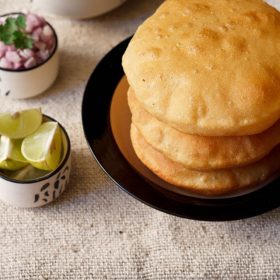
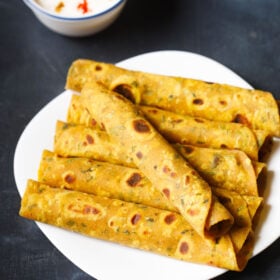










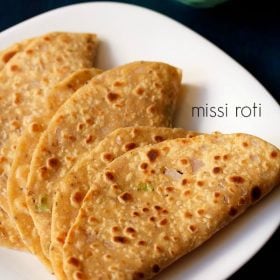
Hi Dassana.
Thanks for sharing the recipe, just one request if you can add nutrition value of each recipe it will be a great help for everyone.
Thanks
Asif
Welcome. We are slowly and gradually updating the nutrition values in the recipes. Thanks.
Great question – would it be possible to ask what is a “serving” on this lovely recipe? Is the nutritional information per 100g? Or per roti? thanks so much
The serving is for 3 people and about 3 to 4 roti for one person.
Hi Dassana
I tried your recipe today. I added amchoor powder and grated ginger in addition to ingredients mentioned in your recipe. The taste was super delicious. Thank you for sharing the recipe.
hi joji, thanks for the feedback and for sharing the variations you made in the missi roti recipe. easily both amchur powder and ginger can be added. in fact different indian herbs & spices can be added. welcome and happy cooking.
Hi Dassana ! This missi roti came out delicious!! I served it with bharwa bhindi and plain curd . Superb!! Thanks a ton for sharing ????????!!
hi angela, thanks for sharing this feedback and the rating too. missi roti with bharwan bhindi and curd is a very good combination. most welcome and happy cooking.
Excellent n yum recepie. V easy to make and taste equally good….????
thank you for the review and rating on missi roti recipe.
very nice recipe
thanks aks
Nice n easy recipe…thank you for sharing
welcome monalisa 🙂
My first search of Alu Capsicum further made me to stop in your Missi Roti. Thanks for both the recipes. I will surely try. Both have a combination too…!
Welcome S.Ram.
Missi roti is yummyyy
Lovely. We usually make them at home. when there is any moong daal left in refrigerator we usually add it to the missi roti and the result is good. Please do try it too.i agree adding onions as they make it more tasty.
thanks harismrat 🙂 thats a good way to use moong lentils. I will try. Sometimes i add chana dal and the taste is good with chana dal too.